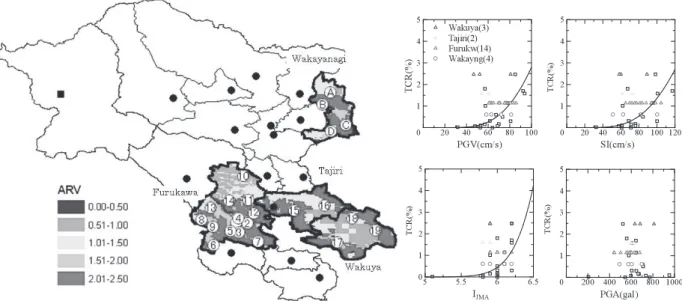第 2 章 研究報告
― 83 ―
13. Variability of estimated ground motions for one subdistrict during the 2011
off the Pacific coast of Tohoku Earthquake
Hao Wu, Kazuaki Masaki, Kojiro Irikura
1.Introduction
The 2011 off the Pacific coast of Tohoku Earthquake occurring on March 11, 2011, brought about catastrophically damage to buildings, infrastructures, lifelines etc., in a wide area along the coast of Tohoku and Kanto regions. The large amount of strong-motion records observed during this earthquake facilitates the understanding of the characteristics of strong ground motions and fault rupture. However, there are still many unknowns in the damaged districts because the strong-motion stations were not installed. One of our research interests is to construct the fragility curves (Wu et al., 2012) of buildings during this earthquake to clarify the relationship between the strong ground motion indices and damage ratios. Therefore it is essential to estimate the ground motions at the damaged sites. On the other hand, the variability of ground motions within one subdistrict should be investigated to assess the representativeness of ground motions at one damaged site.
2.Method of estimating ground motions during the mainshock
The estimation method shown in Fig. 1 is composed of six steps. 1) Microtremor measurement is applied on the ground surface at the target site. 2) Underground velocity structures are identified from the microtremor H/V spectrum by fitting the theoretical H/V (Arai and Tokimatsu, 2000) with the observed one. They are then used to estimate the transfer functions for both horizontal and vertical components. 3) Incident motion at the bedrock is estimated from the observed ground motions of
specific small earthquake. 4) Incident motion at the bedrock during the mainshock is synthesized from the short-period source model (Kurahashi and Irikura, 2013). 5) Transfer function at the target site is estimated through equivalent linear method if the target site is expected to be nonlinearity during the mainshock. 6) Ground motions are estimated from the bedrock incident motions and transfer functions. We (Wu et al., 2013) have verified the effectiveness of this method by comparing the estimated waves on the ground at the strong-motion station with the observed ones.
3.Variability of estimated ground motions in some subdistricts during the mainshock
We have conducted microtremor measurement at damaged sites shown in Fig. 2 with solid circles in the subdistricts
Fig. 1 Illustration of estimating ground motions at a target site during the mainshock
― 84 ― 愛知工業大学 地域防災研究センター 年次報告書 vol. 10 /平成 25 年度
of Osaki and Kurihara cities. The velocity structures are identified and used to estimate the ground motions during the mainshock by the method aforementioned. Then we attempt to construct the fragility curves based on the estimated ground motion indices. However, it is necessary to investigate the representativeness of ground motions in one subdistrict. For instance, amplification factors map in Fig. 2 show the difference from site to site. We therefore add the microtremor measurement near preliminary schools or community centers shown in open circles in Fig. 2 within one subdistrict, such as Wakayanagi, Tajiri, Furukawa, and Wakuya.
The estimated ground motions at the observed sites within one subidistrict are used to calculate the ground motion indices, i. e., PGA (Peak Ground Acceleration), PGV (Peak Ground Velocity), IJMA (Instrumental seismic intensity of
Japan Meteorological Agency) and SI (Spectral Intensity). These indices are shown in Fig. 3, fragility curves for total collapse ratios with different marks. We find that the estimated ground motions at damaged sites (solid circles in Fig. 2) are generally larger than those at the sites with lower amplification factors (open circles in Fig. 2). It implies that the method of estimating ground motions is effective. On the other hand, the variability of estimated ground motions in each subdistrict is almost the same. It suggests that it is advisable to construct the fragility curves in a smaller area, e. g., 200m or 500m centered at the sites where the ground motions are estimated.
4.Conclusion
In this study, we introduced the method of estimating ground motions at target sites during the mainshock. We applied this method to estimate the ground motions at each damaged site, and then investigated the variability of estimated ground motions in four subdistricts. The following conclusions can be obtained:
1) The estimated ground motions are generally consistent with the values of amplification factors. It implies that the method of estimating ground motions during the mainshock is effective.
2) The variability of estimated ground motions in four subdistricts is almost the same. The accuracy of fragility curves is expected to be modified by relating the ground motion indices with damage ratios in a much smaller area than one subdistrict.
Fig. 2 Distributions of microtremor measurement sites and amplification factors map in Furukawa, Tajiri, Wakuya and Wakayanagi
Fig. 3 Fragility curves for total collapse ratios of buildings
第 2 章 研究報告
― 85 ―
参考文献
Wu, H., Masaki, K., Irikura, K., Saguchi, K., Kurahashi, S. and Wang, X., “Relationship between Building Damage Ratios and Ground Motion Characteristics during the 2011 off the Pacific coast of Tohoku Earthquake”, Journal of Natural Disaster Science, Vol. 34(1), pp. 59―78, 2012.
Arai, H. and Tokimatsu, K., “Effects of Rayleigh and Love waves on microtremor H/V spectra”, Proceedings of 12th World Conference on Earthquake Engineering, pp. 2232―2240, 2000.
Kurahashi, S. and Irikura K., “Short-period source model of the 2011 off the Pacific coast of Tohoku Earthquake”, Bulletin of the Seismological Society of America, Vol. 103(2B), pp. 1373―1393, 2013.
Wu H., Masaki K., Irikura K. and karahashi S., “Characteristics of Strong Ground Motions and Fragility Curves of Buildings during the 2011 Tohoku Earthquake”, 日本地震学会講演予稿集 2013 年度秋季大会,B31―03,2013.
